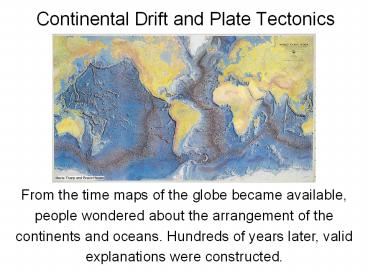Continental Drift and Plate Tectonics - PowerPoint PPT Presentation
Title:
Continental Drift and Plate Tectonics
Description:
... McGeary and Carlson, Physical Geology, 8/e; Hamblin and Christiansen, Earth s Dynamic Systems, 8/e; Press and Siever, Understanding Earth, 3/e; ... – PowerPoint PPT presentation
Number of Views:83
Avg rating:3.0/5.0
Title: Continental Drift and Plate Tectonics
1
Continental Drift and Plate Tectonics
From the time maps of the globe became available,
people wondered about the arrangement of the
continents and oceans. Hundreds of years later,
valid explanations were constructed.
2
Early Observations
Leonardo da Vinci and Francis Bacon wondered
about the possibility of the American and African
continents having broken apart, based on their
shapes.
3
Pangaea
20th century meterologist, Wegener, revived the
early idea of continental drift, contending that
all of the present-day continents were
connected. He called the supercontinental mass
Pangaea, Greek for all lands.
4
Wegeners Evidence
Wegeners summary was based on a number of
careful observations
-- matching rock, fossil, glacier, and structural
relations among different parts of different
continents
5
Continental Drift Fossil Evidence
Similar plant and animal fossils found on
different continents
6
Continental Drift Glacial Evidence
Large ice masses carve grooves in the rocks over
which ice flows. Such masses tend to flow
outward (generally downhill) from a central
locality.
7
Continental Drift Rock Ages
Even before geochronology, the relative
framework of rock ages showed strong correlation
across the Atlantic, as did mountain ranges of
similar age.
8
Mantle Convection
- How do continents drift?
- Arthur Holmes described mantle heat flow in terms
of convection. - Deep materials, hotter than their surroundings
(and hence buoyant), would tend to flow upward. - In approaching the cool surface of the Earth, the
material would lose its thermal energy, cool and
sink, having lost buoyancy.
9
Mantle Convection
Materials that can flow tend to lose thermal
energy by the convection process. A pot of water
heated is similar to under the Earths crust
10
Harry Hess and Marine Geology
From the 1940s to the 60s, Harry Hess made many
key intellectual contributions to the coming
revolution in geologic thought
11
- echo-sounding of sea floor revealed deep sea
features like guyots and seamounts, and the
topography of mid-ocean ridges - -- ridges are areas of high heat flow and
volcanic activity - -- young age of ocean floor, based on thickness
of sediment
12
Topography and Age of the Sea Floor
thin sediment cover
thick sediment cover
As ocean crust ages, it cools and is less
buoyant. The cool mantle root on this crust helps
pull it down into the mantle, resulting in deeper
sea floor progressively away from the ridges.
13
Sea Floor Spreading
Hess combined his observations with the earlier
ideas of Wegener and the mechanism of Holmes into
the concept of sea floor spreading, which
lead to plate tectonics.
14
Credits
Some of the images in this presentation come
from Plummer, McGeary and Carlson, Physical
Geology, 8/e Hamblin and Christiansen, Earths
Dynamic Systems, 8/e Press and Siever,
Understanding Earth, 3/e Paul Tomascak
(University of Maryland)































